
Natick is a town in Middlesex County, Massachusetts, United States. It is near the center of the MetroWest region of Massachusetts, with a population of 37,006 at the 2020 census. 10 miles (16 km) west of Boston, Natick is part of the Greater Boston area. Massachusetts's center of population was in Natick at the censuses of 2000–2020, most recently in the vicinity of Hunters Lane.

John Eliot was a Puritan missionary to the American Indians who some called "the apostle to the Indians" and the founder of Roxbury Latin School in the Massachusetts Bay Colony in 1645. In 1660 he completed the enormous task of translating the Eliot Indian Bible into the Massachusett Indian language, producing more than two thousand completed copies.

The Massachusett were a Native American tribe from the region in and around present-day Greater Boston in the Commonwealth of Massachusetts. The name comes from the Massachusett language term for "At the Great Hill," referring to the Blue Hills overlooking Boston Harbor from the south.
Praying Indian is a 17th-century term referring to Native Americans of New England, New York, Ontario, and Quebec who converted to Christianity either voluntarily or involuntarily. Many groups are referred to by the term, but it is more commonly used for tribes that were organized into villages. The villages were known as praying towns and were established by missionaries such as the Puritan leader John Eliot and Jesuit missionaries who established the St. Regis and Kahnawake and the missions among the Huron in western Ontario.

The Church on the Hill is a historic church building at 169 Main Street in Lenox, Massachusetts. Built in 1805, it is one of a small number of surviving Federal period churches in the region. Its congregation, gathered in 1769, belongs to the United Church of Christ, and its offices are located at 55 Main Street. The church building was listed on the National Register of Historic Places in 1982.
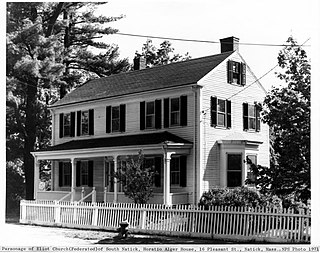
The Parsonage is a historic house at 16 Pleasant Street in Natick, Massachusetts. It was designated a National Historic Landmark for its association with Horatio Alger (1832-1899), a well-known writer of popular juvenile fiction.

The Church of the New Jerusalem is a historic Swedenborgian church at 50 Quincy Street, Cambridge, Massachusetts, near Harvard University. It was added to the National Register of Historic Places in 1983.

The Stephen Bacon House is a historic First Period house in Natick, Massachusetts. Possibly built as early as 1704 by one of Natick's first settlers, it is one of the town's oldest surviving buildings. It was listed on the National Register of Historic Places in 1990.
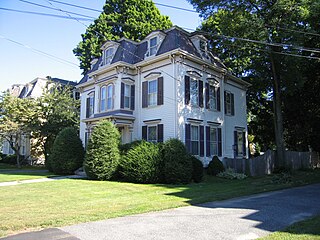
The Clark Houses are historic houses in Natick, Massachusetts. The houses were built in 1870 and added to the National Register of Historic Places in 1978.
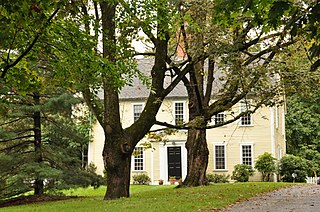
The Rev. Samuel Woodward House is a historic house located at 19 Concord Road in Weston, Massachusetts. Built in 1753, it is a well-preserved example of mid-18th century Georgian architecture. It has also been home to a succession of people significant to the history of the town. It was listed on the National Register of Historic Places in 1976, and was included in Weston's Boston Post Road Historic District in 1983.

The John Eliot Historic District encompasses what was the historic early village center of Natick, Massachusetts. Now the heart of the village of South Natick, it now exhibits a diversity of architecture from the 18th to early 20th centuries, laid out along historic 17th-century colonial routes. It was listed on the National Register of Historic Places in 1983.

The Robert Jenison House is a historic house at 1 Frost Road in Natick, Massachusetts. It is a 2+1⁄2-story wood-frame house, five bays wide, with a side-gable roof, large central chimney, and clapboard siding. The house was built c. 1738 by Robert Jenison. It is one of the town's oldest buildings, and its builder is known to have built a number of other houses in Sudbury and Sherborn. The house was originally part of a 200 acre tract of land that was sold by the Natick Indians despite protests from John Eliot. There is an outbuilding on the property that is marked as the site where Vice President Henry Wilson learned to make shoes.

The Marshall Symmes House is a historic house in Winchester, Massachusetts. Built c. 1817, it is a rare local example of Federal period brick-end house, and is further notable for its association with the Symmes family, who were among Winchester's earliest settlers. The house was listed on the National Register of Historic Places in 1989.

St. Mark's Episcopal Church is an historic Episcopal church building at Zero Freeland Street in Worcester, Massachusetts. The Romanesque Revival stone building was designed by local architect Stephen C. Earle, and built in 1888 for a congregation established the preceding year. On March 5, 1980, the church building was added to the National Register of Historic Places as St. Marks. The current priest is the Rev. Robert Carroll Walters.

The House at 6 Adams Street in Wakefield, Massachusetts is one of the best examples of Shingle style architecture in the town. It was designed by Boston architect Robert Pote Wait and built in 1885–86 to be his own home. It was listed on the National Register of Historic Places in 1989.
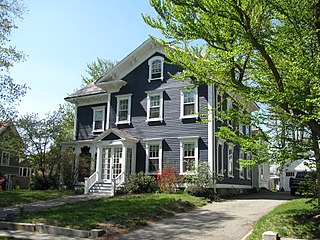
The House at 23 Avon Street in Wakefield, Massachusetts is one of the town's finest examples of Italianate. It was built about 1855, and was listed on the National Register of Historic Places in 1989.
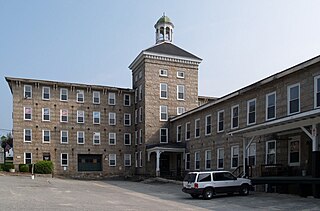
The Manchaug Village Historic District is a historic district encompassing the 19th century industrial village center of Manchaug in Sutton, Massachusetts. Developed in the 1820s around textile mills on the Mumford River, it was the largest industrial area in Sutton, with at least three mill complexes in operation. The district is centered on the junction of Main Street with Manchaug, Putnam Hill, and Whitins Roads.

Daniel Takawambait was likely the first ordained Native American Christian pastor in North America, and served the church in the praying town of Natick, Massachusetts from 1683 to 1716. Takawambait also advocated for indigenous land rights in colonial Massachusetts, and authored at least one publication.
Magunkaquog was one of the Christian indigenous praying towns established by the missionary John Eliot near the Massachusetts Bay Colony. Magunkaquog was established in 1660. The name came from the oaks and chestnuts which were growing in the area.
The Praying Indians of Natick were a community of Indigenous Christian converts, known as Praying Indians, in the town of Natick, Massachusetts, one of many Praying Towns. They were also known as Natick Indians.




















